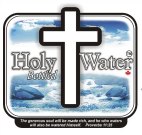Searing Meat Seals in Its Juices (and other food myths) —
Status: Urban Legend
I know a lot of people who swear by the notion that you have to sear meat "to seal in its juices." But I've always thought the idea was a bit far-fetched (though I agree that meat is best cooked hot and fast), so it pleased me to read, in
a review of Alan Davidson's Oxford Companion to Food, that most food experts agree that it is indeed an urban legend that searing meat will seal in its juices.
About.com's barbeque expert agrees:
By definition, searing is to cook something hot and fast to brown the surface and to seal in the juices. Yet many of the leading cooking experts agree that searing does not seal in juices. Frankly the idea that you can somehow melt the surface of the meat into a material that holds in all the juices seems a little strange to me. But whether you believe searing seals in juices or not, a great cut of meat needs hot, dry heat to caramelize or brown the surface to give it that great flavor.
The same review of Davidson's
Oxford Companion to Food lists a number of other food myths. For instance:
MSG Causes Headaches (aka Chinese Restaurant Syndrome): "Jeffery Steingarten, food editor of the Vogue in New York, debunked this myth pretty comprehensively. Given the widespread use of MSG in China, he asked why weren’t there a billion Chinese people with headaches? He then went around relentlessly researching the theory in his characteristically thorough way, and came to the conclusion that MSG, taken in normal quantities, was perfectly safe." (I know many people who swear they get headaches after eating MSG, so I'm reluctant to accept this as an urban legend. But some quick research reveals that a
controlled study at Harvard University also concluded that MSG in food doesn't cause headaches.)
Croissants were invented during the 1529 Siege of Vienna, when a baker who foiled a Turkish plan to breach the city's walls was rewarded by being given a royal licence to produce crescent-shaped pastries: "Davidson debunks this romantic legend and informs us that in fact, the first reference to croissants did not appear until 1891, more than two centuries after the siege of Vienna."
In the Middle Ages spices were used to mask the flavor of spoiled meat: "Davison cites Gillian Riley to rubbish the notion... Indeed, in pre-refrigeration days, we had assumed that the role of spices and heavy sauces was to conceal the fact that meat had spoiled. Riley makes the valid point that in those days, spices were far too expensive to be used for this purpose."
Chop Suey was invented by a Chinese restaurant in California which threw together odds and ends ('chop suey' in Chinese) as a meal for drunken miners: "according to Anderson, quoted by Davidson, chop suey is a local dish from Toisan, a rural district south of Canton. In Cantonese, its name is tsap seui, meaning 'miscellaneous scraps'."

 This is an odd marketing gimmick. This company is selling Holy Bottled Water. Of course, the label could easily be mistakenly read as Holy Water Bottled. But it's not holy water (in the sense of water that's been blessed by a priest). It's just regular old bottled water. The closest they come to explaining why their water is holy is this cryptic claim:
This is an odd marketing gimmick. This company is selling Holy Bottled Water. Of course, the label could easily be mistakenly read as Holy Water Bottled. But it's not holy water (in the sense of water that's been blessed by a priest). It's just regular old bottled water. The closest they come to explaining why their water is holy is this cryptic claim: I've posted before about chewy vodka bars, which are
I've posted before about chewy vodka bars, which are  This really shouldn't surprise me, but for some reason it does. A company has developed peanut butter slices that come in packs (similar to packs of sliced cheese). I'm not sure how they made the peanut butter rigid enough, and non-sticky enough, that it could be formed into a plastic-wrapped slice. But somehow they did. I'd be worried that whatever they did to it would affect the taste. No word on whether anyone has developed sliced jam. [Update: they have; see the comments below.] I think if you're going to eat sliced peanut butter, you naturally should have it on Sara Lee's crustless bread. It would be the perfect meal for anyone too lazy to do anything on their own. (Thanks to Kathy for giving me a heads up about this product)
This really shouldn't surprise me, but for some reason it does. A company has developed peanut butter slices that come in packs (similar to packs of sliced cheese). I'm not sure how they made the peanut butter rigid enough, and non-sticky enough, that it could be formed into a plastic-wrapped slice. But somehow they did. I'd be worried that whatever they did to it would affect the taste. No word on whether anyone has developed sliced jam. [Update: they have; see the comments below.] I think if you're going to eat sliced peanut butter, you naturally should have it on Sara Lee's crustless bread. It would be the perfect meal for anyone too lazy to do anything on their own. (Thanks to Kathy for giving me a heads up about this product)
 The newest thing for Halloween is fake pumpkins. Made out of polyurethane foam, they can be carved just like the real thing. But don't try to eat the seeds. A guy quoted about this issue in the Loudoun Times-Mirror notes that: "There's something wrong with society if people start carving plastic pumpkins." I don't think I have anything to add to that statement. The article also notes that once you've carved your foam pumpkin, it wouldn't be wise to light it up with a candle. You need to use a flashlight.
The newest thing for Halloween is fake pumpkins. Made out of polyurethane foam, they can be carved just like the real thing. But don't try to eat the seeds. A guy quoted about this issue in the Loudoun Times-Mirror notes that: "There's something wrong with society if people start carving plastic pumpkins." I don't think I have anything to add to that statement. The article also notes that once you've carved your foam pumpkin, it wouldn't be wise to light it up with a candle. You need to use a flashlight.



 Given the urban legend about kids eating pop rocks and soda, and then having their stomachs explode, I wouldn't have believed that mixing Mentos and soda could cause such a violent reaction. But after watching the video posted on WLTX's website, I do. (You need Windows Media Player to view it, and I had to click the "Trouble Viewing" button to make it work.) To summarize what the video shows, three Mentos are dropped into a bottle of soda, causing a geyser of soda to shoot up about three or four feet high out of the bottle. This really makes me wonder what would happen if you drank a can of soda and then downed a pack of Mentos. Personally I'm not planning to find out. I'm sure it wouldn't kill you, but I imagine it would fizz up into your throat and nose. WLTX provides this scientific explanation for the phenomenon:
Given the urban legend about kids eating pop rocks and soda, and then having their stomachs explode, I wouldn't have believed that mixing Mentos and soda could cause such a violent reaction. But after watching the video posted on WLTX's website, I do. (You need Windows Media Player to view it, and I had to click the "Trouble Viewing" button to make it work.) To summarize what the video shows, three Mentos are dropped into a bottle of soda, causing a geyser of soda to shoot up about three or four feet high out of the bottle. This really makes me wonder what would happen if you drank a can of soda and then downed a pack of Mentos. Personally I'm not planning to find out. I'm sure it wouldn't kill you, but I imagine it would fizz up into your throat and nose. WLTX provides this scientific explanation for the phenomenon:
 I suppose it's no worse than candy cigarettes, or Shirley Temples, but it just seems kind of weird. It's 'Kidsbeer', now being sold in Japan. It looks like beer, but it's not. It's really just a yellow-colored cola beverage that comes in a brown bottle. So kids can drink it and pretend to be beer-guzzling adults. It's marketed with the slogan: "Even kids cannot stand life unless they have a drink."
I suppose it's no worse than candy cigarettes, or Shirley Temples, but it just seems kind of weird. It's 'Kidsbeer', now being sold in Japan. It looks like beer, but it's not. It's really just a yellow-colored cola beverage that comes in a brown bottle. So kids can drink it and pretend to be beer-guzzling adults. It's marketed with the slogan: "Even kids cannot stand life unless they have a drink."
 94-year-old Harry Tomlinson was amazed when his apple tree began to grow plums and blackberries, as well as apples. The 'fruit salad' tree generated some media interest, but horticulturalists took one look at the tree and saw that the plums and blackberries had simply been pasted on. The identity of the hoaxer remains unknown (assuming that it wasn't Mr. Tomlinson himself).
94-year-old Harry Tomlinson was amazed when his apple tree began to grow plums and blackberries, as well as apples. The 'fruit salad' tree generated some media interest, but horticulturalists took one look at the tree and saw that the plums and blackberries had simply been pasted on. The identity of the hoaxer remains unknown (assuming that it wasn't Mr. Tomlinson himself).